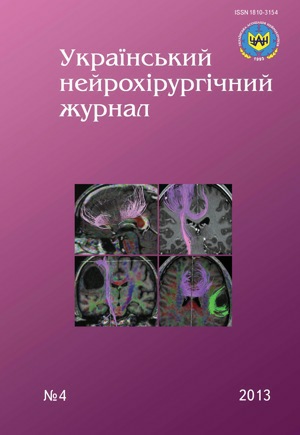The analysis of treatment results of brain aneurysms rupture
DOI:
https://doi.org/10.25305/unj.55409Keywords:
brain aneurysm, angiospasm, microsurgery, endovascular treatmentAbstract
Introduction. The problem of surgical treatment of brain aneurysms is unsolved, and results of treatment don’t satisfy neurosurgical community. The indications and terms of surgery performing are most discussed.
Purpose. To determine main causes of unfavorable outcomes of surgical treatment of patients with brain aneurysms rupture on the base of analysis of our own clinical experience.
Materials and methods. The results of treatment of 1099 patients with ruptured brain aneurysms were analyzed. 99 patients died without surgery. Microsurgical approach was used in 706 patients, endovascular — in 294.
Results. The cause of death of 50% patients who died without surgery was brain aneurysms re-rupture. Postoperative lethality was 9.0% after microsurgical technique use, and 9.2% — after endovascular one. Lethality when using both methods differed significantly depending on terms after brain aneurysm rupture.
Conclusion. In the acute period of brain aneurysm rupture (1–3 days) the surgery has to be performed just in patients without clinical signs of angiospasm. Lethality after endovascular surgery in this period is 2.5 times lower than after microsurgical operations.References
1. Tsutsumi K, Ueki K, Morita A, Kirino T. Risk of rupture from incidental cerebral aneurysms. J Neurosurg. 2000 Oct;93(4):550-3. [CrossRef] [PubMed]
2. Komotar RJ, Mocco J, Solomon RA. Guidelines for the surgical treatment of unruptured intracranial aneurysms: the first annual J. Lawrence pool memorial research symposium — controversies in the management of cerebral aneurysms. Neurosurgery. 2008;62:183-94. [CrossRef]
3. Haley EC Jr, Kassell NF, Torner JC. The International Cooperative Study on the Timing of Aneurysm Surgery. The North American experience. Stroke. 1992 Feb;23(2):205-14. [CrossRef] [PubMed]
4. Yamashiro S, Nishi T, Koga K, Goto T, Muta D, Kuratsu J, Fujioka S. Postoperative quality of life of patients treated for asymptomatic unruptured intracranial aneurysms. J Neurosurg. 2007 Dec;107(6):1086-91. [CrossRef] [PubMed]
5. Krylov VV, editor. Khirurgiya anevrizm golovnogo mozga [Brain aneurysm surgery]. Moscow: Avtorskij tirazh; 2011;1. Russian.
6. Sugawara T, Ayer R, Jadhav V, Chen W, Tsubokawa T, Zhang JH. Mechanisms of statin treatment in cerebral vasospasm. Acta Neurochir Suppl. 2011;110(Pt 2):9-11. [CrossRef] [PubMed]
7. Doukas A, Petridis AK, Barth H, Jansen O, Mehdorn HM. Continuous intra-arterial infusion of nimodipine at the onset of resistant vasospasm in aneurismal subarachnoidal haemorrhage. Technical report. Neurol. Res. 2011;33(3):290-4. [CrossRef]
8. Enomoto Y, Yoshimura S, Yamada K, Iwama T. Convulsion during intra-arterial infusion of fasidil hydrochloride for the treatment of cerebral vasospasm following subarachnoid hemorrhage. Neurol. Med. Chir. (Tokyo). 2010;50:7-11. [CrossRef]
9. Jabbour PM, Tjoumakaris SI, Rosenwasser RH. Neuroendovascular management of vasospasm following aneurysmal subarachnoid hemorrhage. Neurosurg. Clin. N. Am. 2009;20:441-6. [CrossRef]
10. Jestaedt L, Pham M, Bartsch AM, Kunze E, Roosen K, Solymosi L, Bendszus M. The impact of balloon angioplasty on the evolution of vasospasm-related infarction after aneurismal subarachnoid hemorrhage. Neurosurgery. 2008;44:610-7. [CrossRef]
11. Kassell NF, Torner JC, Haley EC Jr, Jane JA, Adams HP, Kongable GL. The International Cooperative Study on the Timing of Aneurysm Surgery. Part 1: Overall management results. J Neurosurg. 1990 Jul;73(1):18-36. [CrossRef] [PubMed]
Downloads
Published
How to Cite
Issue
Section
License
Copyright (c) 2013 Mykola Zorin, Sergiy Grygoruk, Illya Plyushchev, Andriy Miroshnychenko, Yuri Cherednychenko, Dmytro Garus

This work is licensed under a Creative Commons Attribution 4.0 International License.
Ukrainian Neurosurgical Journal abides by the CREATIVE COMMONS copyright rights and permissions for open access journals.
Authors, who are published in this Journal, agree to the following conditions:
1. The authors reserve the right to authorship of the work and pass the first publication right of this work to the Journal under the terms of Creative Commons Attribution License, which allows others to freely distribute the published research with the obligatory reference to the authors of the original work and the first publication of the work in this Journal.
2. The authors have the right to conclude separate supplement agreements that relate to non-exclusive work distribution in the form of which it has been published by the Journal (for example, to upload the work to the online storage of the Journal or publish it as part of a monograph), provided that the reference to the first publication of the work in this Journal is included.









